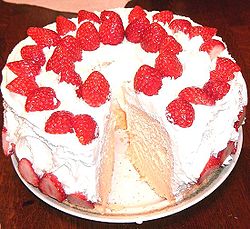Chiffon cake
A chiffon cake is a very light cake made with vegetable oil, eggs, sugar, flour, baking powder, and flavorings. It is a combination of both batter and foam type cakes. In contrast to butter, the traditional fat used in cake making, it is difficult to beat air into oil, so chiffon cakes, like angel cakes and other foam cakes, achieve a fluffy texture by beating egg whites until stiff, and folding them into the cake batter before baking. Its aeration properties rely on both the quality of the meringue and the chemical leaveners. Its oil-based batter is initially blended before folding into the meringue.Characteristics The high oil and egg content creates a very moist cake, and as oil is liquid even at cooler temperatures, chiffon cakes do not tend to harden or dry out as traditional butter cakes might. This makes them better-suited than many cakes to filling or frosting with ingredients that need to be refrigerated or frozen, such as pastry cream or ice cream. Chiffon cakes tend to be lower in saturated fat than butter cakes, potentially making them healthier than their butter-heavy counterparts. The lack of butter, however, means that chiffon cakes lack much of the rich flavor of butter cakes, and hence they are typically served accompanied with flavorful sauces or other accompaniments, such as chocolate or fruit fillings. Hokkaido cake, a chiffon cupcake that's filled with cream, French Baker (Philippin

s) [edit]History The chiffon cake was invented in 1927 by Harry Baker, a California insurance salesman turned caterer. Baker kept the recipe secret for 20 years until he sold it to General Mills. At this point the name was changed to "chiffon cake" and a set of 14 recipes and variations was released to the public in a Betty Crocker pamphlet published in 1948. A vegetable oil is a triglyceride extracted from a plant. Such oils have been part of human culture for millennia.[1] The term "vegetable oil" can be narrowly defined as referring only to substances that are liquid at room temperature,[2] or broadly defined without regard to a substance's state of matter at a given temperature.[3] For this reason, vegetable oils that are solid at room temperature are sometimes called vegetable fats. Vegetable oils are composed of triglycerides, as contrasted with waxes which lack glycerin in their structure. Although many plant parts may yield oil,[4] in commercial practice, oil is extracted primarily from seeds. On food packaging, the term "vegetable oil" is often used in ingredients lists instead of specifying the exact plant being used. It usually means palm oil, which has been produced in larger quantities than any other edible oil, but can refer to soybean oil, or sometimes canola oil that has been artificially hydrogenated. The latter two are often specified in brackets, whereas "palm oil" is seldom specified.